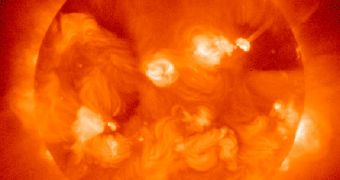For the past century, as astronomers kept tabs on solar activity, a fairly predictable pattern emerged. The star would run in 11-year-long cycle, alternating periods of solar maximum and solar minimum. But this predictable cycle turned out not to be so predictable after all, as it was made abundantly obvious over the past couple of years. Estimates had it that the Sun would go into a minimum between 2008 and 2009. That it did, but what it failed to do is come out of it. Now, as solar activity is rising back to normal, the star is acting as if it's about to enter a solar minimum again, Space reports.
“We're witnessing something unlike anything we've seen in 100 years,” explains solar scientist David Hathaway, who is based at the NASA Marshall Space Flight Center, in Huntsville, Alabama. The image of the faltering Sun was made very clear last month, at the 216th meeting of the American Astronomical Society (AAS 2010). Numerous studies presented here addressed the star's patterns of activity, and very few of them arrived at positive, promising conclusions. The prolonged solar minimum has in fact forced experts to return to the drawing board and recalculate their models.
“We found that there were variations in the strength of that [meridional] flow. The last minimum in 1996, that velocity was about 11 meters per second (about 22 miles an hour), which is pretty slow for an object as big as the Sun. That flow slowed down as we went to maximum in 2001,” the expert adds. The meridional flow is extremely important for a star, as it represents the total amount of mass that is circulating between the equator and the poles. Its strength can significantly influence the overall behavior of a star, and so experts have been keeping on eye on it for years.
“My suspicion is that this sunspot cycle 23 [the last one] was a weaker cycle than the last two, with fewer sunspots and weaker magnetic fields. These may feed into what happens with the meridional flow that is going to lead to another weak cycle,” the expert explains, saying that the new solar maximum (of cycle 24) should peak at around 2013. But he adds that the intensity of the upcoming solar maximum will be but half of that recorded during the previous three solar maximums.
One of the things hindering the researchers in their quest is the relative lacking in significant data. Studies on the Sun have been carried out rigorously for little more than a century, and so only 23 solar cycles were thus far observed. “One problem we have with all solar cycle studies is the statistics of small numbers. Even with 23 sunspot cycles, it's not enough. What we've seen today are some newer measurements that weren't available even two cycles ago that are shedding new light. We need to be careful with using what we've seen from one or two cycles to make inferences for all of them,” Hathaway concludes.

 14 DAY TRIAL //
14 DAY TRIAL //